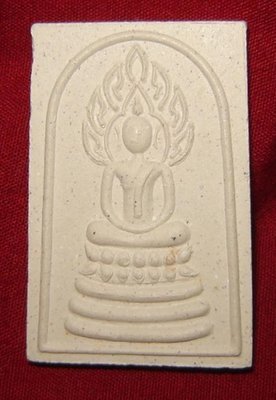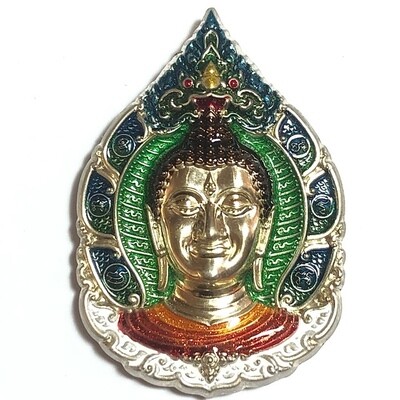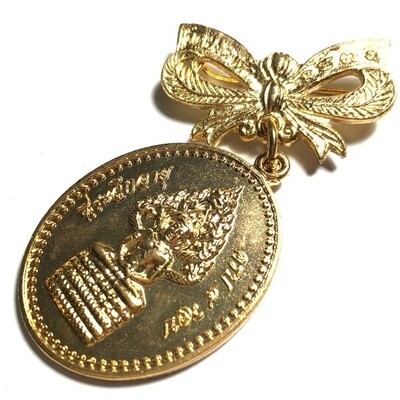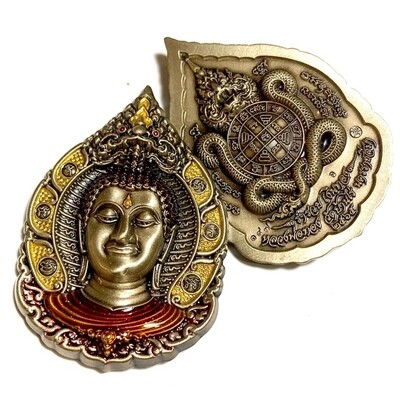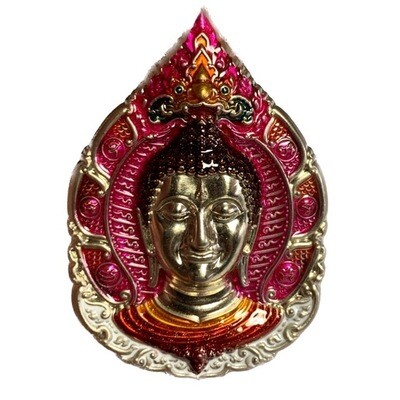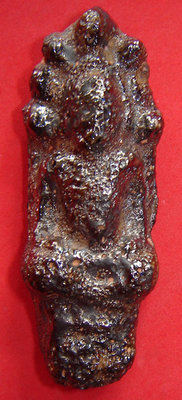

Thailand Amulets
Thai Buddhist and Magical amulets for Wealth, Health, Love and Happiness.
Vast Selection of Amulets
We have a vast selection of over 4000 different kinds of Sacred Amulets and Bucha Items, including Buddha Image, Loi Ongk statuettes, Buddhist Monk Coin Amulets, Takrut Charms, Nam Man Prai Oils, Mai Kroo Wands, Mitmor Ritual Knife, Lek Lai Kaya Siddhi Elemental Substance, Kumarn Tong, Gambling Amulets, Mae Nang Prai, Muan Sarn Sacred Powder Amulets, Palad Khik, Animist Charms, Necromantic Amulets, Buddhist, Animist, Brahman and Necromantic Amulets.
Rian Nakprok Sao Ha Maha Sethee 2557 BE Nuea Albaca - Luang Por Mian - Wat Ban Janiang
Limited Edition Rian Pra Nakprok Sao Ha Maha Sethee 2557 BE Coin Amulet, with Khmer style Buddha on Naga Throne, and Yantra on rear face, in Nuea Albaca with limited series code stamp, from Luang Por Mian, of Wat Ban Janiang Wonaram. This amulet is highly recommended for those born on Saturdays, as their auspicious 'Birthday Buddha' to increase Good Karma (Serm Duang). The front face of the amulet features the Buddha sat in Meditation on a coiled 7 headed Naga Throne, depicting the moment a Naga rose over the buddha to make a canopy for him to shelter from the rain.
Above the Buddha are the words 'Mian Ngern Mian Tong' Invoking Wealth (Silver and Gold). Below the Buddha image are the words 'Sao 5' (เสาร์๕), meaning 'fifth Lunar Saturday. The blessing of this edition was given 4 separate empowerment ceremonies, before the 5th and final blessing was performed on Saturday the 5th of April 2557 BE. This final Blessing was performed on a 5th Lunar Saturday, for the Auspicious Empowerment of the Pra Nakprok and other amulets in Buddha Abhiseka Ceremony. The amulets were then released on the 19th April 2557 BE for distribution.
The rear face of the amulet has the Yant Dto with the Pali Kata 'NA MŌ PUT TĀ YA' and 'PUT TA SANG MI' embossed around the Yant. Below the Yant Dto is the Kata 'UTTANG ADT-TÕ' (Gunstopper Heart Mantra). Around the bottom edge of the coin is the name of the temple 'Wat Ban Janiang Amphoe Grasang Janghwat Buriram'. The top edge of the coin has a Khmer Pali Kata Invocation written based in Kampuchean Dhamma Wicha.
This edition included Pra Rian and Rian Kanajarn (Buddha Coins and Monk Coins), Bia gae, Gamlai Bracelets, Mitmor, Takrut, Pra Pid Ta, Pra Somdej, Pra Kring, Lockets, Pra Sivali Loi Ongk Statuettes, Pra Khun Phaen Muan Sarn Sacred Powders Amulets, Roop Lor Luang Por Mian Loi Ongk Statuettes, Luang Por Mian Bucha Statues, Kumarn Tong, Nang Kwak, and Pra Nakprok Loi Ongk Statuettes.
The front face of the amulet has the series number code stamp, and a small hand made inscription made by Luang Por Mian on the surface of the coin.
Luang Por Mian is a Master Gaeji Ajarn of the South Eastern Isan, with Powerful Mastery over the Khmer Sorcery Arts. Luang Por is especially renowned for his Wicha Kumarn Tong, which is becoming ever more Famous and spreading ever further afield. Luang Por Mian, abbot of Wat Janiang Wonaram, in Buriram, is a Khmer Gaeji Ajarn Master Monk of Kampuchean Lineage, and one of the few remaining living Masters who received Wicha from the Great Luang Phu Suang (Taewada Len Din), Legendary 500 year-Old Monk of Wat Ban Rarom in Sri Saket.

Luang Por Mian is one of the Great 20th Century Masters of the Southern Isan Province. Highly revered and regarded for his amulets and occult charms, he has received national news coverage at least three times for his powerful amulets, and his inheritance of the Wicha of Luang Phu Suang Taewada len Din. His Wicha is so highly regarded by other Sorcerors, that even the great Pra Ajarn Dtua of Wat Sap Lam Yai, direct apprentice to Luang Por Guay (Wat Kositaram) and Luang Phu Hmun (Wat Ban Jan), beseeched apprenticeship to Luang Por Mian.
Luang Por Mian was born in the year 2482 BE in Ban Bpaneum, in Tambon Beung Khanaa, in the Province of Bodhisattva, in Kampuchea. he ordained at the age of 10 years old as a Samanera Novice Monk, and remained ordained, reaching the age of 20, he then ordained again to the elevated status of a fully fledged Bhikkhu. He studied and practiced Wicha Akom (Khmer Buddha Magic and Sorcery) with 12 different Kampuchean Masters.
Amongst these masters, Luang Por Mian gives particular reference and respect for the powerful Wicha they bestowed upon him, were Pra Ajarn Lun, first and foremost, after which, for the Wicha Hun Payont, he gives respectful reference to his own Grandfather, who was a famous lay sorceror of the time, and passed this Wicha on to Luang Por Mian as a young boy.
During the time he was still practicing as a monk in Kampuchea, he traveled for many years on Tudong in the forests, from one place to another, until his sixth year of adult ordination (age 26). it was then that his country fell into civil war, and many atrocities were occurring, with even mass killings of young ordained Samanera Novice Monks occurring.
Luang Por Mian then disrobed and fled to the Dta Praya Municipal District in the year 2519 BE and stayed out of sight of the Khmer Rouge. He then later reordained into the Sangha again in Thailand and traveled around on Tudong solitary forest wandering through the provinces along the Thai-Khmer border. He arrived at Sri saket, and decided to stay here to intensify his practice. He spent 5 years studying Wicha with the Great Luang Phu Suang, and also received additional training in Wicha Akom from Luang Phu Jiam Adtisayo.
Luang Por Mian was also a very close colleague and co-practitioner with Luang Phu Tammarangsri, another great Gaeji Ajarn of the time. After making many practicing under these masters for many years, Luang Por Mian received the request to become the abbot of Wat Ban Janiang, and administrate the temple, and care for its Devotees, in the year 2536 BE.
Since then, this great Khmer Master has remained at Wat Ban Janiang, and became the source of faith and spiritual comfort of the people of Sri Saket, His inheritance of the Lineage Wicha of the Great Luang Phu Suang has carried many Devotees of Luang Phu Suang to give allegiance and devotion to Luang Por Mian, as the continuance of the Wicha of the Great Miracle Monk of Sri Saket, Luang Phu Suang, Taewada len Din 500 Pi.
The amulets of Luang Por Mian are highly sought after and prized by both Devotees and Collectors alike, and have received much acclaim in the Wongarn Pra Niyom amulet appreciation clubs and societies, especially his Coin type amulets of the Maha Lap Maha Sethee edition, his Hanuman Maha Lap Bpraab Pairee, Pra Kring Boroma Kroo Ganlayano Medicine Buddha Statuette, and many many other amulets.
Kata for Saturday Buddha (Pra Nakprok)
Yadtohang Pakiniariyaaya Chaadtiyaa Chaadto Naapichaanami Sanjijja Bpaanang Chiiwidtaa Wo Ro Bpedtaa Dtena sajjena So Dti Dte Ho Dtu Kappassa
The Pra Nakprok is an image of the Buddha sitting in Samamadhi (concentrative meditation), on top of a Naga, the Naga's head is raised over Buddha's to form a canopy. It is known as "Bpaang Nakprok"
The Buddha remained in blissful rapture under the Acabhalanikaroda for seven days, whereupon he moved to the Mucalinda tree to the Southeast side of the Bodhi tree. A terrible rainstorm began, pouring down on the forest for a whole seven days without stopping. Payanaga Mucalinda, who was King of the Nagas, came up from the naga Realm in the underworld and coiled himself underneath the Buddha, making a cushion seven stories high, to keep him dry.
He rose up and leaned his head over the Lord opening his neck canopy to shade the Buddha from the rain, as well as keeping watch to protect him from all sorts of parasitic, poisonous and preying animals and creatures. As the rains ceased to fall, the Naga King uncoiled and changed into a Human form and raised his hands in reverence to Buddha.
In this moment, the Buddha uttered the following Kata (words);
Sukhoewiwego Dtudtassa Sudtadhammassa Bpassadtoe Abhayaabpach-chang Sukhang Loke Bpaanapuudtesuu Sanyamosukhaa Wiraakadtaa Loke Gaamaanang Smadtiggamo Asmimaanassa Winayo Edtang We Bparamang Sukhang
"Tranquility is the pleasure of he who has listened to and understood the Dharma intently, who sees conditioned things for what they really are, and does not seek to harm others. Of he who has abolished his passions and cravings, lust and desires, he who has stepped beyond all craving for sensual pleasures and endured in his efforts to do away with self conceited attitudes, has the greatest pleasure".
The statue of Buddha sitting on seven coils of the Naga King snake was created to remember this occasion of the Naga paying reverence to Lord Buddha, and the representation of him sitting on top of the coils as if seated upon a royal throne is used for two reasons; 1. Aesthetics, 2. Brahmin influence
A more authentic and historical version of this Buddha image is sometimes seen in the form of the Nagas coils wrapped around and covering the Buddha's body with four or five coils around him. The only part of the body visible being Lord Buddha's shoulders, neck and head, which is also semi enclosed by the head and canopy of the Naga leaning over him.
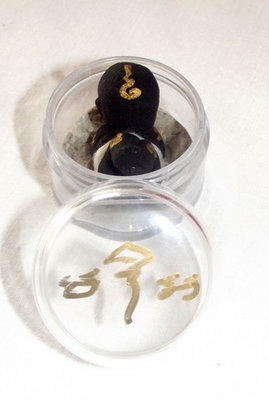

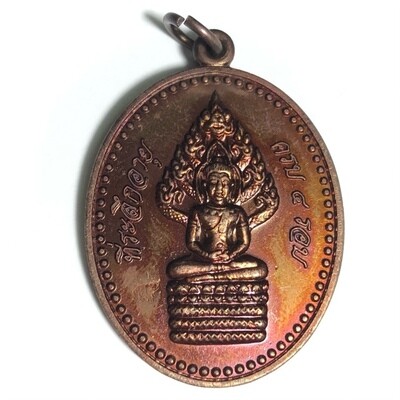
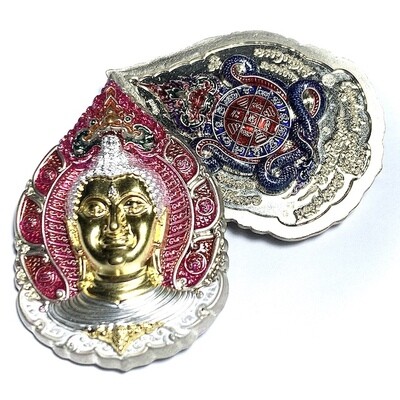

Contact Us
Follow Us on Youtube
About Us
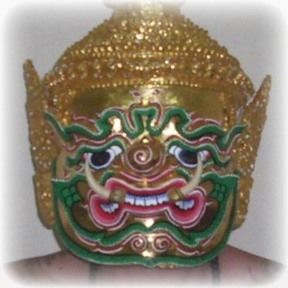
Ajarn Spencer
Proprietor
Thailand Amulets is owned and Administrated by Thai Occult and Amulet expert, Ajarn Spencer Littlewood who guarantees only authentic blessed amulets, and a free gift with every order, as well as his safe delivery or money back guarantee. https://facebook.com/ajarnspencer



















